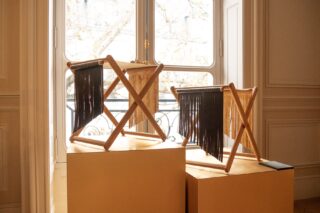During Maison&Objet, we sit down with the creator of the Apollo wooden wheelchairs to discuss the history and manufacturing of the mobility devices.
Apollo Wooden Wheelchairs has emerged as a standout at the 2024 Maison&Objet Paris fair, winning the Future On Stage competition with its innovative approach to mobility aids. This French startup is revolutionizing wheelchair design by transforming these essential devices into aesthetically pleasing and highly functional objects, crafted primarily from wood. The use of wood offers a warm, natural alternative to traditional metal structures and allows for extensive customization, with designs ranging from sleek and minimalist to elegantly curved forms.
Maison&Objet, known for highlighting cutting-edge design and sustainability, provided the perfect platform for Apollo to showcase its vision. The company’s commitment to environmental responsibility is evident in its use of wood sourced from sustainable French forestry practices, and its innovative approach to incorporating recycled materials into production. This focus on sustainability aligns with the growing demand for eco-friendly products in the design world, making Apollo’s wheelchairs functional and environmentally conscious.
Apollo’s success at Maison&Objet underscores its potential to reshape the design and medical industries. Apollo Wooden Wheelchairs is setting a new standard for mobility aids, demonstrating how thoughtful design can enhance users’ physical and emotional well-being. For architecture and design professionals, Apollo represents a future where everyday objects are practical, beautifully crafted, and sustainably produced.



ArchiExpo e-Magazine: Could you introduce yourself and tell us about your project?
Paul de Livron: My name is Paul de Livron, I’m 32 years old, from Paris, France. Two years ago, I founded Apollo Wooden Wheelchairs, a project I started after an accident that left me paraplegic. Before the accident, I was an IT engineer, but afterward, I found a new passion in woodwork and design, which helped me create something meaningful.
ArchiExpo e-Magazine: Why did you choose to work with wood for your wheelchair project?
Paul de Livron: Initially, I was more interested in using metal for the wheelchairs, but one day, I realized it was entirely possible to create functional wheelchairs out of wood. Wood has a lot of advantages—it’s durable, strong, and aesthetically pleasing. I started making prototypes, and when I tested one in the streets of Paris, I received positive feedback. It motivated me to explore this further.
ArchiExpo e-Magazine: How do you plan to personalize the chairs for individual users?
Paul de Livron: The idea is to offer a wide range of models that can be tailored to each person’s needs. The technique I developed allows for different customizations, such as adding various accessories or adjusting the design to meet personal preferences. Each wheelchair can be as unique as the person using it.


ArchiExpo e-Magazine: Have you received feedback from industrial partners or on the use of wood in wheelchairs?
Paul de Livron: I’ve met with some industrialists by chance, but no formal partnerships have been established yet. As for wood, while I’m not the first to use it in wheelchairs, wood has largely disappeared from this industry over the past few decades. Today, I’m the only one making modern wheelchairs with wood, which is both durable and strong. For example, the cushions I designed are holding up well, even after crash tests. They’re not as tough as titanium or carbon fiber, but they’re sufficiently durable for everyday use.
ArchiExpo e-Magazine: What challenges do you foresee in bringing this to a larger market?
Paul de Livron: The main challenge is finding an industrial partner who can help scale production. Another hurdle is navigating regulatory requirements in different countries, especially when it comes to obtaining government reimbursements for medical equipment.



ArchiExpo e-Magazine: Do you see a potential use for your wheelchairs in hospitals or retirement homes?
Paul de Livron: Absolutely. While each chair can be customized for individuals, I can also imagine creating models specifically designed for retirement homes or medical centers, with features that cater to elderly users. The aesthetics and comfort of the wheelchair could enhance the well-being of residents.
ArchiExpo e-Magazine: Any personal experiences that inspired this direction?
Paul de Livron: Yes, I have a great-aunt who, after breaking her hip, was asked to use a wheelchair. She struggled with the idea and resisted using it. I believe that if the wheelchair had been more aesthetically pleasing and blended better with her home environment, it might have improved her quality of life.
ArchiExpo e-Magazine: What’s the ultimate goal of your project?
Paul de Livron: My goal is to make wheelchairs accessible, not just in wealthy countries but also in developing nations. I’ve traveled to places like India, where I saw the need for affordable, functional mobility aids. I believe wood can be the solution in these regions, where access to high-tech materials may be limited. My hope is to create a wheelchair that is both beautiful and accessible to people worldwide.











